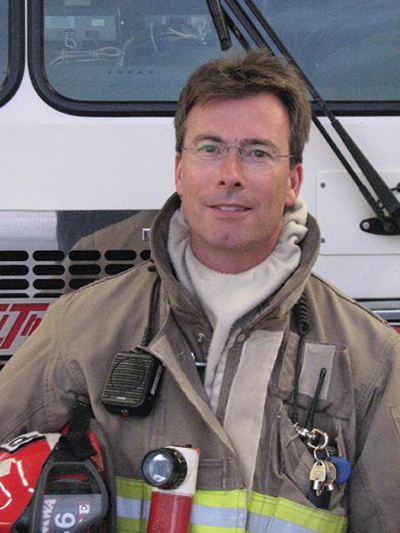
Features
Structural
Training
Fire IQ: July 2009
When I began my fire service career 30 years ago, my department equipped me and my fellow firefighters with the best personal protective equipment available. Our standard issue consisted of a pair of thigh-high rubber boots, a three-quarter-length petch coat, rubber gloves and a pretty decent Cairns helmet with ear flaps.
June 19, 2009
By Peter Hunt
 |
|
When I began my fire service career 30 years ago, my department equipped me and my fellow firefighters with the best personal protective equipment available. Our standard issue consisted of a pair of thigh-high rubber boots, a three-quarter-length petch coat, rubber gloves and a pretty decent Cairns helmet with ear flaps.
Our demand-type SCBA was carried in suitcases in the apparatus compartments; we responded in open cabs and we never dreamed of wearing seatbelts.
Throughout the ’80s, fire-service manufacturers made incredible advances in almost every aspect of equipment related to firefighter safety and survival. PPE got better, stronger and lighter while innovative items emerged regularly.
Being a fairly progressive department, supported by a relatively wealthy city, my chiefs, like many others, took full advantage of these opportunities to provide us with a seemingly endless supply of equipment that allowed us to respond faster and advance farther into burning buildings while remaining extremely well protected.
Despite dramatic advancements in firefighter PPE, tools and equipment, there is one area to which the industry, our chiefs and our firefighters have been slow to respond, and one that I am convinced will join the standard-issue list within the next couple of years. Today’s firefighter is going further into and working longer in hotter fires consuming lighter buildings. It seems logical – and anecdotal evidence seems to support this theory – that firefighters will occasionally need to exit these buildings rapidly (rescue themselves) through the nearest window to escape flashover, sudden extension of fire or impending structural collapse.
In most cases, as a result of established strategy and tactics, training, ground or aerial ladder placement and a bit of luck, these emergency bails amount to nothing more than close calls and some pretty exciting stories to tell around the coffee table.
Unfortunately, crews cannot anticipate every threat, be aware of every means of emergency egress or ladder every window during a rapidly escalating fire fight. Firefighters have been injured and killed as a result.
Recent tragedies in New York City prompted the FDNY, in collaboration with Petzl (EXO), to equip every suppression member with a state-of-the-art self-rescue system. A subsequent lobby effort resulted in legislation requiring that every firefighter in the state eventually be trained and equipped with a similar system. I am not aware of any Canadian fire department that has issued self-rescue systems to its members.
Due in large part to the events in New York, where a demand was created virtually overnight, fire service manufacturers are responding with effective, affordable, rapidly deployable self-rescue systems that will allow departments to provide this long-overdue life-saving tool to their members.
All legitimate NFPA-compliant self-rescue systems have four common elements: a harness (preferably Class II); rope or webbing; a hands-free friction device; and an anchoring device such as a hook, carabiner or loop.
It is essential that firefighters and chiefs understand that in those critical moments, members cannot deploy personal rope stored in their pockets or create the necessary friction with their hands to safely descend.
Thanks to the typical ingenuity of firefighters and fire service manufacturers, self-rescue systems have evolved in three distinct ways: external harnesses; harnesses sewn into bunker gear; and harnesses integrated into SCBA. Rope or webbing is typically carried in a cut/heat resistant pouch. A hands-free friction device allows the operator to quickly determine the distance from anchor point to window then use both hands to exit. Systems using external harnesses and those sewn into bunker gear require that departments purchase one system for each member who is then responsible for checking and maintaining the equipment. Systems integrated into SCBA require that far fewer be purchased; however, they demand daily checks by the member and that maintenance become an added responsibility of the SCBA program.
As with any new equipment, training of personnel is critical and will determine the success of any self-rescue program. Since firefighters are skilled in rope work and typically enjoy rappelling, initial training leading to competency should take about eight hours. An ongoing schedule to maintain skills is required.
Like some other fire-service disciplines, self-rescue is a high-risk/low-frequency event, and, as such, many departments will have a tough time justifying the costs, training and maintenance associated with such a program.
A self-rescue program may be more palatable if it can be demonstrated that it works well with DRDs in rescue/removal of downed firefighters and possibly as fall restraint during roof work.
In the 30 years since this story began, more than 100 firefighters have died and thousands more have been injured in the line of duty. Will the inevitable introduction of self-rescue systems affect these tragic statistics when the already long list of new and improved PPE, tools and equipment has not?
I choose to believe that without the continuing innovations of firefighters and fire service manufacturers, countless more lives would have been lost. I am convinced that the ability to safely exit a burning building when all conventional methods have failed is an option that our firefighters must have.
Peter Hunt, a 29-year veteran of the fire service is a captain in the Ottawa Fire Department’s suppression division. He can be reached at peter.hunt@rogers.com
Print this page